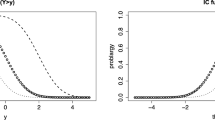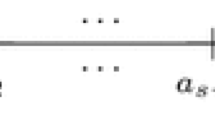Abstract
A rating response mechanism for ordered categories, which is related to the traditional threshold formulation but distinctively different from it, is formulated. In addition to the subject and item parameters two other sets of parameters, which can be interpreted in terms of thresholds on a latent continuum and discriminations at the thresholds, are obtained. These parameters are identified with the category coefficients and the scoring function of the Rasch model for polychotomous responses in which the latent trait is assumed uni-dimensional. In the case where the threshold discriminations are equal, the scoring of successive categories by the familiar assignment of successive integers is justified. In the case where distances between thresholds are also equal, a simple pattern of category coefficients is shown to follow.
Similar content being viewed by others
Reference notes
Rasch, G.A mathematical theory of objectivity and its consequences for model construction. Paper presented at the European meeting on statistics, econometrics and management science. Amsterdam, 1968.
Andrich, D.Applications of a psychometric model for ordered categories scored with successive integers. Paper presented at the A.E.R.A. Conference, New York, April, 1977.
Kolakowski, D. & Bock, R. D.A Fortran IV program for maximum likelihood item analysis and test scoring: Logistic model for multiple item responses (Res. Mem. 13). Chicago, Ill.: Statistical Laboratory, Department of Education, University of Chicago, 1972.
Waller, M.Estimating parameters in the Rasch model: Removing the effects of random guessing (ETS RB-76-8). Princeton, NJ: Educational Testing Service, 1976.
References
Andersen, E. B. Conditional inference for multiple-choice questionnaires.British Journal of Mathematical and Statistical Psychology, 1973,26, 31–44.
Andersen, E. B. Sufficient statistics and latent trait models.Psychometrika, 1977,42, 69–81.
Birnbaum, A. Some latent trait models and their use in inferring an examinee's ability. In F. Lord & M. Novick,Statistical theories of mental test scores. Reading: Mass. Addison-Wesley, 1968.
Lord, F. A theory of test scores.Psychometric Monograph,7, 1952.
Lumsden, J. Person reliability.Applied Psychological Measurement, 1977,4, 477–482.
Rasch, G. On general laws and the meaning of measurement in psychology. InProceedings of the Fourth Berkeley Symposium on Mathematical Statistics and Probability. Berkeley: University of California Press, 1961, 321–34.
Samejima, F. Estimation of latent ability using a response pattern of graded scores.Psychometric Monograph, 1969,34 (2, Whole No. 17).
Author information
Authors and Affiliations
Additional information
This work was conducted in part in the first half of 1977 while the author was on study leave at the Danish Institute for Educational Research. The Institute provided required research facilities while The University of Western Australia provided financial support.
Rights and permissions
About this article
Cite this article
Andrich, D. A rating formulation for ordered response categories. Psychometrika 43, 561–573 (1978). https://doi.org/10.1007/BF02293814
Received:
Revised:
Issue Date:
DOI: https://doi.org/10.1007/BF02293814




